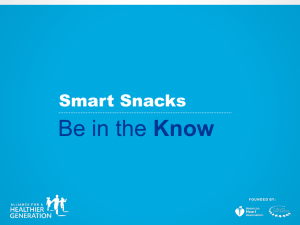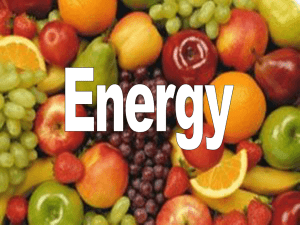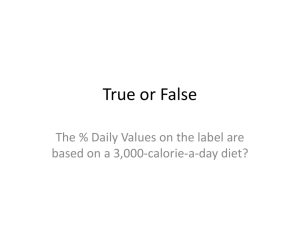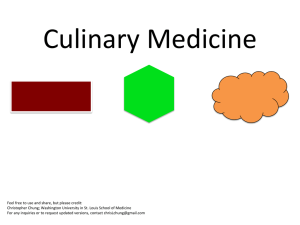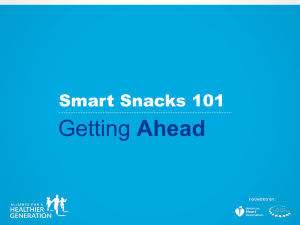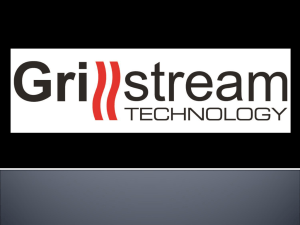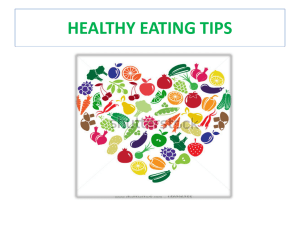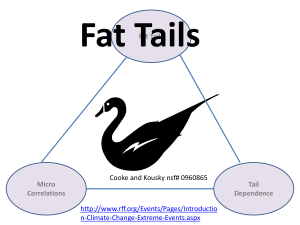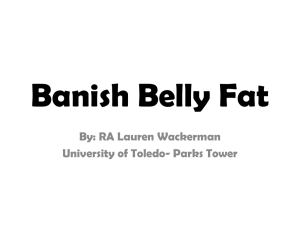Swimming and Nutrition - Bishopsworth Swimming Club
advertisement
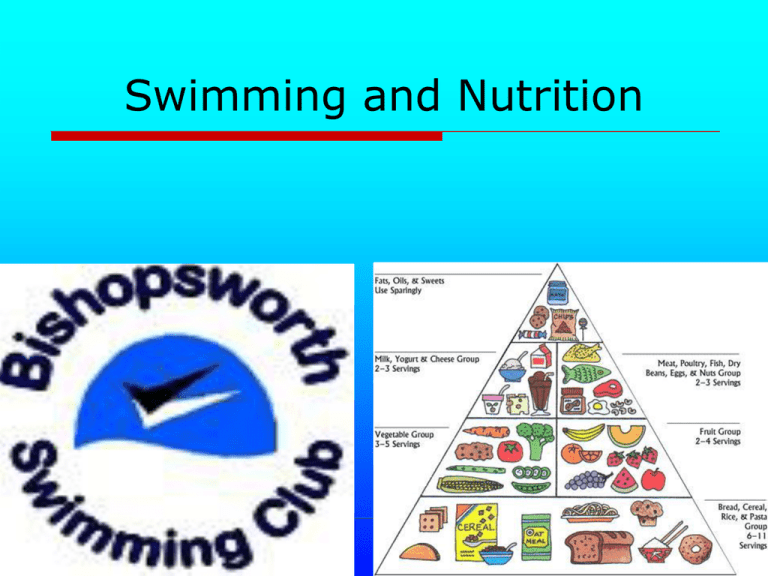
Swimming and Nutrition Swimming and Nutrition The Basics of good eating Carbohydrate foods + Glycemic Index Fats Proteins Before, during and after events Fluids During the week The Basics Our body can obtain energy from 3 Components in food: Carbohydrates (glucose, sugar) Fats Protein (amino acids) Food also contains fibre, water, vitamins, minerals eg calcium, iron. Carbohydrate CHO’s break down into glucose (sugar) Body’s favourite type of energy. The body uses it to make our heart, brain and muscles work. Glucose is stored in long chains called ‘glycogen’ . Glycogen is stored in our muscles and liver. What happens when we exercise ? Our body burns glycogen, releasing glucose into the muscles for energy. Our supplies will last about 30-45 minutes....training uses our supplies. To train and compete we need to make sure we have a full ‘tank’ of glycogen. Your aim is to keep your glycogen levels as full as possible so you can train and swim more effectively and recover quicker. Low levels cause sore muscles and tiredness. What happens when we don’t have enough glycogen ? Dizzy, nauseous, hungry, in ‘slow motion’ this is called ‘hitting the wall’. Your body sends a signal to start breaking down muscles to release glucose. This will happen if you are constantly running out and you don’t ‘top up’. How much CHO do I need ? At least 8g per kg body weight eg. 60kg = min 480g CHO each day. ‘what does this mean - how much food should I eat ?’ To work this out you need to know how much CHO is in food.… CHO containing foods Fruit, fruit juice, dried fruit, tinned fruit. Bread, cereal, rice, pasta, muesli bars. Milk, yoghurt, custard, ice cream. sugar, glucose, honey. potato, sweet potato, corn. baked beans, lentils, kidney beans. The Glycemic Index Some CHO’s release their glucose slowly, and others quickly. This is important. e.g. if your glycogen stores are low – to top them up quickly you need to eat the quick release CHO. The Glycemic Index is a ranking of CHO foods based on how quick they release glucose. Just because something is sweet doesn’t necessarily mean it will break down into glucose quickly. CHO’s that break down quickly have a high GI number. Those that break down slowly have a low GI number. The numbers range between 0-120. Glucose =100 and all foods are compared to it. How can it help my swimming ? High GI foods in recovery to top up glycogen stores quickly. High GI foods and fluids during training maintain glucose levels. Low GI foods 2-3 hours before events and training help keep glucose levels going longer. See the table of foods and GI values. Breakfast Cereal Bread Low GI All-bran (UK) All-bran (US) Oat bran Rolled Oats 30 50 50 Bran Buds Mini Wheats Nutrigrain Low GI High GI Medium GI Cornflakes 80 Sultana Bran 73 Branflakes 74 58 66 Coco Pops 77 67 Puffed Wheat 80 Special K (UK) 54 Oats in Honey Bake 77 Natural Muesli 40 Porridge Oats 63 Team 82 Porridge 58 Special K (US) 69 Total 76 Cheerios 74 Rice Krispies 82 Weetabix 74 Wholegrain Pumpernickel High GI 36 58 51 Shredded Wheat Soya and Linseed Medium GI 46 Heavy Mixed Grain 45 Whole Wheat 49 Sourdough Rye 48 Sourdough Wheat 54 Croissant 67 Hamburger bun White 71 61 Bagel 72 Pita, white 57 French Baguette 95 Wholemeal Rye 62 Vegetables High GI Medium GI Low GI Frozen Green Peas Legumes (Beans) Beetroot 64 Pumkin 75 39 Parsnips Frozen Sweet Corn Medium GI Low GI 97 Kidney Beans (canned) 52 Butter Beans 36 Beans in Tomato Sauce 56 47 Raw Carrots 16 Boiled Carrots 41 Dairy Chick Peas 42 Medium GI Low GI Eggplant/ Aubergine 15 Broccoli 10 Cauliflower 15 Cabbage 10 Mushrooms 10 Tomatoes 15 Chillies 10 Lettuce 10 Green Beans 15 Red Peppers 10 Onions 10 Haricot/Navy Beans 31 Lentils, Red Whole milk 31 21 Skimmed milk 32 Lentils, Green 30 Chocolate milk 42 Pinto Beans 45 Sweetened yoghurt 33 50 Artificially Sweetened Yoghurt 23 Custard 35 Soy Milk 44 Blackeyed Beans Yellow Split Peas 32 Icecream 62 Snacks & sweet food Staples Low GI Medium GI Wheat Pasta Shapes 54 New Potatoes 54 Meat Ravioli 39 Spaghetti 32 Tortellini (Cheese) 50 Egg Fettuccini 32 Brown Rice 50 Buckwheat 51 White long grain rice 50 Pearled Barley 22 Yam 35 Sweet Potatoes 48 Instant Noodles 47 Wheat tortilla 30 Basmati Rice 58 Couscous 61 Cornmeal 68 Taco Shells 68 Gnocchi 68 Canned Potatoes 61 Chinese (Rice) Vermicelli Low GI High GI Instant White Rice 87 Glutinous Rice 86 Short Grain White Rice 83 Tapioca 70 Fresh Mashed Potatoes 58 French Fries Baked Potatoes 60 Instant Mashed Potatoes Wild Rice 57 73 75 80 Slim-Fast meal replacement High GI Medium GI 27 Snickers Bar (high fat) 41 Nut & Seed Muesli Bar 49 Sponge Cake 46 Nutella 33 Milk Chocolate 42 Hummus 6 Peanuts 13 Walnuts 15 Cashew Nuts 25 Nuts and Raisins 21 Jam 51 Corn Chips 42 Oatmeal Crackers 55 Ryvita 63 Pretzels 83 Digestives 59 Water Crackers 78 Blueberry muffin 59 Rice cakes 87 Honey 58 Puffed Crispbread 81 Donuts 76 Scones 92 Maple flavoured syrup 68 Fruit Medium GI Low GI Cherries 22 Plums 24 Grapefruit 25 Peaches 28 Peach, canned in natural juice 30 Apples 34 Pears 41 Dried Apricots 32 Grapes 43 Coconut 45 Coconut Milk 41 Kiwi Fruit 47 Oranges 40 Strawberries 40 Prunes 29 High GI Mango 60 Sultanas 56 Bananas 58 Raisins 64 Papaya 60 Figs 61 Pineapple 66 Watermelon 80 Dates 103 Fats All swimmers should follow a low fat diet. Low fat levels help us move through water faster. Too much fat slows performance. Don’t diet - it slows your performance. Your body needs the calories for energy ! 30% Fat Rule It is recommended that swimmers should eat high carbohydrate low fat meals. Low fat is defined as food items with less than 30% fat by calories. This is NOT the value that is presented by the food manufacturers, who display fat content by weight, which makes the foodstuff appear to be “healthier” than it usually is. How can you work out the real fat content in food, so that they can be accepted or rejected as appropriate? An easy way to calculation the true fat content of food: Each gram of fat produces 9.3 kcal. This value is close to 10 which can be used as the “rule of thumb’ value. 1. Look at the label on the food item and see how many grams of fat it contains per serving. 2. Multiply the number of grams by 10 to calculate the number of kcal from fat per serving. 3. Look at the label for the total energy, the number of kcal per serving. 4. Divide the kcal from fat by the total kcal and multiply by 100. You now have the TRUE fat content of the food stuff. Examples of 30% fat rule 1. McCain oven chips: The front of the packet claims to be “LESS THAN 5% FAT”. The label shows that there are 5.4 grams of fat per serving. Our “rule of thumb” gives a value of 54 kcal per serving (5.4 x 10). The label shows that there are a total of 163 kcal per serving. The % fat content is, therefore, 54 divided by 163 times 100 = 33.1% This is greater than 30%, therefore, these chips should be rejected by the swimmer. 2. Salad is an excellent food but what about the dressing? Be Good To Yourself Salad Cream (Sainsbury) claims to be “60% less Fat”. Is this OK? The label on the jar shows that a serving has 14.0g fat, which gives 140 kcal, from the “rule of thumb”. The total calories per serving is 210 kcal. 140 divided by 210 times 100 = 66.7% Fat. Decision: Reject! 3. Baked Beans in Tomato Sauce (Tesco): A 100g portion provides 0.3g Fat = 3 kcal. Total energy = 85 kcal %Fat content = 3 divided by 85 times 100 = 3.5 % Decision: Accept Eating low fat 2 sources of fat- visible & invisible. Visible = fat on meat, chicken skin, margarine and oil. Invisible = milk, cheese, chips, meat, takeaways, biscuits. Bad fats Saturated fats; Are found in animal fats and produce made with palm oil or palm kernal oil. They raise blood cholesterol levels and increace the risk of heart disease. No more than 10% of total calorie intake should come from saturated fats Trans fats; Are even more harmful than saturated fats. Most are formed artificially when vegetable oils are converted into hardened hydrogenated fats. Often used in cakes, biscuits and pastries. They increase LDL (bad cholesterol) in the blood while lowering HDL (good cholesterol) Good fats Monounsaturated fats; Lower harmful LDL cholesterol level. Main sources include: olive oil, avocados, peanuts almonds, cashews, peanut butter, sunflower and sesame seeds. Polyunsaturated fats; Are extremely important for maintaining correct structure of the cell membranes in the body. Found in sunflower oil, nuts and seeds Omegas Omega-3 fatty acids; Found in fish oils, they are necessary for proper brain function, regulating hormones, for the immune system and blood flow. For regular exercisers, omega-3s increase the delivery of oxygen to muscles, and improve aerobic capacity and endurance. They also help speed up recovery and reduce inflammation and joint stiffness. Main sources are: sardines, mackerel, salmon, walnuts, pumpkin seeds and sweet potato. Omega-6 fatty acids; Are easier to find in foods than omega-3 and for that reason, most people eat too much omega-6 in relation to omega-3, which can result in an imbalance in hormones that control inflammation and the immune system. Main sources are: sunflower oil and seeds, corn oil, olive oil, peanuts and sesame seeds. Protein Is needed for the growth, formation and repair of body cells. Athletes need more protein than inactive people to compensate for the increase muscle breakdown that occurs during and after intense exercise, as well as to build new muscles cells. You will need about 1.2-1.8g of protein per kg of bodyweight daily e.g. 60kg person should consume between 72-108g of protein daily. MYTH: to build muscle you need to take protein powders. Foods high in protein include: Meat, chicken, fish, eggs. Milk, yoghurt, custard, cheese, ice cream. Baked beans, lentils etc. Small amounts in breads and cereals, veggies. Pre - event meals Aim is to top up glycogen stores. Boost fluid levels. Stop hunger during events/ training. The meal before an event CAN’T replace a poor diet during the week. Should eat 3-4 hours before the events/ training. Pre - event meal tips Top up 1-2 hours before. Make sure it is low fat, high CHO. Trial low GI types. If nervous try low fibre choices. Drink, drink ,drink. porridge, yoghurt + fruit, toast + jam or honey, meal replacement shake, milkshake or smoothie. During training Top up blood sugars and fluid. Don’t wait till thirsty - you will be too dehydrated to be performing at your best at that stage. Water, cordial, diluted fruit juice After the event / training 30 Minute Rule: The muscles are most susceptible to restoration of carbohydrate stores within the first 30 minutes after exercise. Thereafter, the process becomes progressively more difficult. The swimmer should eat 50 to 100 grams of carbohydrate, whilst keeping fat ingestion low, as soon as training finishes, and definitely within the first 30 minutes after training. The following are examples of appropriate snack foods and their approximate carbohydrate content: An apple, banana or orange: 15-20g Muller rice: 20g Nutrigrain Elevenses bar: 25-30g Fruit Shake or Smoothie: 25-30g per glass 1 thick Jam or Honey sandwich (no or minimal butter): 50g Malt Loaf (Soreen): 18g per eighth of a loaf Fig Rolls: 13g per biscuit Chocolate milk: 59g Other excellent snacks: Rice cakes, dried fruit, flapjack It is advised to then eat a bigger meal which includes a portion of protein within 2 hours Fluids Only a small number of athletes replace the amount of fluid they have lost during the activity. Some even start out dehydrated before the events /training. Urine = clear /pale yellow is good. Swimmers need lots of fluid - hot environment, not aware of losses. Do’s and Dont’s of fluid Don’t rely on thirst. Drink every hour. Don’t drink Coke, Redbull, Monster etc before a events = dehydrating effect and too much sugar and bad sweeteners. Do avoid drinks containing Acesulfame-k and Aspartame! Do look at your urine. Water is good if you have topped up your glycogen stores before the event. Do have a drink bottle at the end of the lane. Drink during breaks and between sets. Try Diluted fruit juice, cordials, water etc. Healthy eating during the week A good diet is low in fat, high in CHO, high fibre, adequate protein, calcium and iron. Learn food labels, eat low salt foods. Eat regular meals and snacks to make sure you are eating enough CHO. Eat a rainbow (colourful foods) every day. Try to eat whole foods (not processed) as much as possible. Recipes Walnut and date flapjacks 150g (5oz.) butter 60g (2oz.) light brown sugar 5 tbsp golden syrup 200g (7oz.) porridge oats 60g (2oz.) chopped dates 100g (3.5oz.) chopped walnut 1. 2. 3. 4. 5. Pre heat oven to 180C lightly oil 9 inch square baking tin Put butter, sugar and syrup in saucepan and heat together, stirring occasionally, until the butter has melted, remove from heat Mix the oats, dates and walnuts until thoroughly combined Transfer the mixture into prepared tin, level the surface and bake in the oven for 20 mins until golden brown around the edges but still soft in the middle Leave in tin to cool. While still warm, score into 12 bars with a sharp knife Banana cake 2 large bananas 250ml orange juice 300g (10oz.) self raising flour (half wholemeal, half white) 125g (4oz.) brown sugar pinch of salt half tsp each of mixed spice and cinnamon 1 egg 1 tbsp oil 1. 2. 3. 4. 5. Mash the banana with orange juice Mix together the flour, sugar, salt and spices in a bowl. Add the banana juice mixture together with the egg and oil. Combine together. Spoon into lightly oiled 900g (2lb) loaf tin. Bake at 170C for about 1 hour. Check the cake is cooked by inserting a knife into the centre, it should come out clean. Good sports nutrition books Anita Bean – food for fitness £10.50 Ann Litt – food for young athletes £10.99
